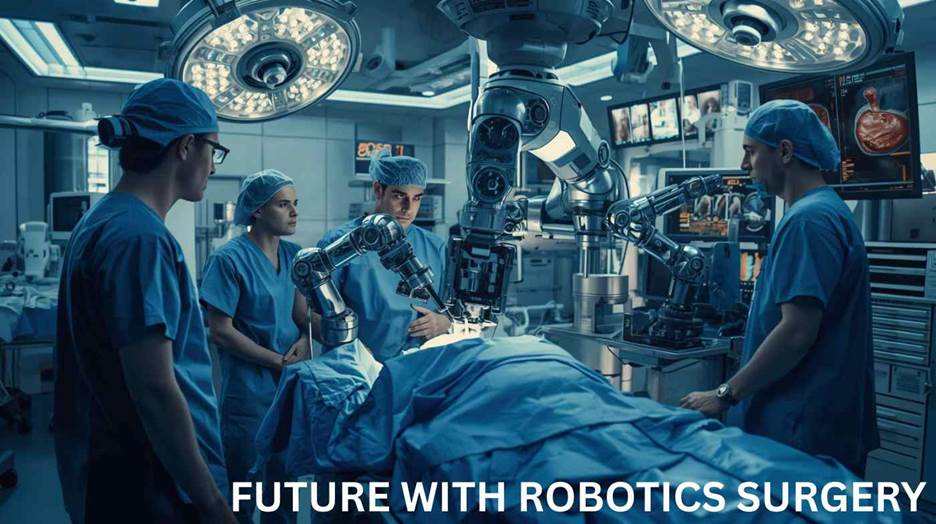Advancements in medical science have always transformed the way healthcare is delivered. Among the most groundbreaking innovations is Robotics Surgery, a technique that combines surgical expertise with cutting-edge robotic technology. It has reshaped the surgical landscape, offering precision, safety, and faster recovery to patients worldwide. This article explores how Robotics Surgery is revolutionizing medicine, its benefits, challenges, and the future it holds.
Table of Contents

Understanding Robotics Surgery
What Is Robotics Surgery?
Robotics Surgery refers to surgical procedures performed with the assistance of robotic systems controlled by skilled surgeons. Unlike traditional surgeries that rely solely on a surgeon’s hands, this approach enhances accuracy through robotic arms, 3D visualization, and minimally invasive techniques.
How It Works
During Robotics Surgery, the surgeon operates from a console equipped with a high-definition screen and hand controls. Every movement of the surgeon is translated into precise actions by the robotic arms. This ensures greater control and reduces the risk of human error.
Benefits of Robotics Surgery
Enhanced Precision
One of the biggest advantages of Robotics Surgery is the unmatched precision it offers. Robotic arms can rotate and maneuver in ways that human wrists cannot, allowing surgeons to perform complex procedures with high accuracy.
Reduced Recovery Time
Minimally invasive techniques used in Robotics Surgery lead to smaller incisions, less blood loss, and reduced scarring. This means patients spend less time in hospitals and can return to normal activities much faster.
Lower Risk of Complications
Because Robotics Surgery allows for detailed visualization and greater dexterity, it minimizes the chances of surgical errors. The improved accuracy reduces risks such as infections or accidental damage to surrounding tissues.
Applications of Robotics Surgery
Cardiothoracic Procedures
Robotics Surgery is widely used in heart and lung operations. Surgeons can repair valves, treat coronary conditions, and perform bypass surgeries with minimal trauma.
Urological Surgeries
In procedures like prostate removal, Robotics Surgery has become the gold standard. It offers better control, reduced bleeding, and improved patient outcomes.
Gynecological Operations
Women undergoing hysterectomies or fibroid removal greatly benefit from Robotics Surgery, which allows safer and less invasive procedures.
Orthopedic Interventions
Joint replacements and spinal corrections are becoming more advanced through Robotics Surgery, where precision is crucial for alignment and mobility.

Challenges in Robotics Surgery
High Cost
One of the biggest hurdles in the adoption of Robotics Surgery is its high cost. Robotic systems are expensive, and not all hospitals can afford them. Patients may also face higher treatment bills compared to traditional surgery.
Training and Expertise
Although robotic systems enhance capabilities, Robotics Surgery requires specialized training. Surgeons must adapt to new techniques and gain experience with the equipment, which can take time.
Limited Accessibility
In many developing countries, access to Robotics Surgery remains limited due to financial and infrastructural constraints. This creates disparities in the availability of advanced healthcare.
The Future of Robotics Surgery
Integration with Artificial Intelligence
The future of Robotics Surgery will likely involve artificial intelligence. AI can analyze patient data, assist in decision-making, and further improve surgical outcomes.
Expansion of Tele-Surgery
With the help of high-speed internet and robotics, surgeons could perform Robotics Surgery remotely, bringing advanced medical care to underserved areas.
Miniaturization and Innovation
Robotic systems are expected to become smaller, more affordable, and easier to use. This will make Robotics Surgery more accessible to hospitals worldwide.
Patient Perspective on Robotics Surgery
Improved Confidence
Patients often feel more confident knowing their procedures involve the precision of robotic systems. The combination of human expertise and robotic support in Robotics Surgery gives them peace of mind.
Faster Healing Journey
Because of reduced pain and shorter hospital stays, patients undergoing Robotics Surgery enjoy a smoother and faster healing journey compared to traditional surgery.
Conclusion
Robotics Surgery is more than just a medical advancement; it is a transformation in how healthcare is delivered. With enhanced precision, minimal invasiveness, and improved recovery, it has already saved countless lives and improved patient experiences. While cost and accessibility remain challenges, the future looks promising as technology continues to evolve. As hospitals and surgeons worldwide embrace this innovation, Robotics Surgery will become a cornerstone of modern medicine, ensuring safer, faster, and more effective treatments for patients everywhere.